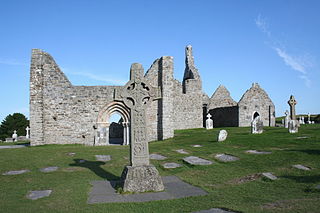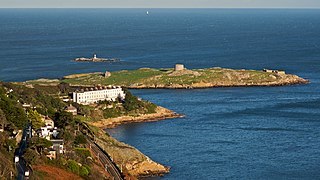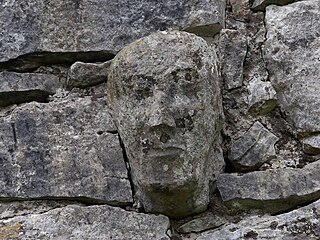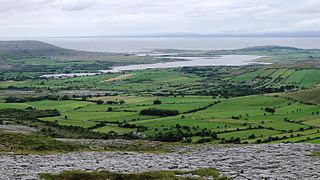
Gisborough Priory is a ruined Augustinian priory in Guisborough in the current borough of Redcar and Cleveland, North Yorkshire, England. It was founded in 1119 as the Priory of St Mary by the Norman feudal magnate Robert de Brus, also an ancestor of the Scottish king, Robert the Bruce. It became one of the richest monastic foundations in England with grants from the crown and bequests from de Brus, other nobles and gentry and local people of more modest means. Much of the Romanesque Norman priory was destroyed in a fire in 1289. It was rebuilt in the Gothic style on a grander scale over the following century. Its remains are regarded as among the finest surviving examples of early Gothic architecture in England.
The Prittlewell royal Anglo-Saxon burial or Prittlewell princely burial is a high-status Anglo-Saxon burial mound which was excavated at Prittlewell, north of Southend-on-Sea, in the English county of Essex.

Clonmacnoise is a ruined monastery situated in County Offaly in Ireland on the River Shannon south of Athlone, founded in 544 by Saint Ciarán, a young man from Rathcroghan, County Roscommon. Until the 9th century it had close associations with the kings of Connacht.

Dalkey Island is an island for which the nearby village of Dalkey is named. It is an uninhabited island located in the county of Dún Laoghaire-Rathdown, about 16 km (9.9 mi) south of Dublin and 3 km (1.9 mi) south of Dún Laoghaire harbour. An important site of pilgrimage for centuries, it has been known as "St Begnet's Isle" since records began. The earliest reference to 'Dalkey Island' is from c. 1782. The island had a population of 8 in 1841.

St Pancras Old Church is a Church of England parish church on Pancras Road, Somers Town, in the London Borough of Camden. Somers Town is an area of the ancient parish and later Metropolitan Borough of St Pancras.

Temple Church, also known as Holy Cross Church, is a ruined church in Redcliffe, Bristol, England. It is on the site of a previous, round church of the Knights Templar, which they built on land granted to them in the second quarter of the 12th century by Robert of Gloucester. In 1313 the Knights Hospitaller acquired the church, following the suppression of the Templars. By the early 14th century, the church served as the parish church for the area known as Temple Fee. From around the same time, the rebuilding of the church on a rectangular plan started. This was completed by 1460, with the construction of a leaning west tower. The Hospitallers would lose ownership of the church in 1540 during the Dissolution of the Monasteries.

A cillín is a historic burial site in Ireland, primarily used for stillborn and unbaptized infants. These burial areas were also used for the recently deceased who were not allowed in consecrated churchyards, including the mentally disabled, suicides, beggars, executed criminals, and shipwreck victims.

The Monastery of Rates was a Benedictine monastery located in the parish of Rates in the municipality of Póvoa de Varzim, in Portugal. The part of the monastery that has survived to this day is the bell-tower and, most importantly, the Church dedicated to St Peter of Rates, mostly known as Romanesque Church of Rates, which is a national monument since 1910. Reconstruction of the church began at the turn of the 11th to the 12th century, turning it into one of the oldest extant Romanesque churches in Portugal.

Temple Cronan is a ruined medieval oratory or chapel built near a holy well in the Burren, County Clare, Ireland. The current building apparently dates from the 12th and 15th centuries, although it may partly incorporate earlier buildings or some of the masonry thereof. It may have been the site of an early Christian monastery. Temple Cronan is located in the civil parish of Carran, eight miles from Corofin and about sixteen miles from Ennis.

Nendrum Monastery was a Christian monastery on Mahee Island in Strangford Lough, County Down, Northern Ireland. Medieval records say it was founded in the 5th century, but this is uncertain. The monastery came to an end at some time between 974 and 1178, but its church served a parish until the site was abandoned in the 15th century. Some remains of the monastery can still be seen.

Clare Abbey, also known as Clareabbey, is a ruined Augustinian monastery located near the Town of Ennis, along the banks of the Fergus River, and about a mile north of Clarecastle in County Clare, Ireland. The Abbey, founded in 1189, was the largest and most important of the Augustinian monasteries in County Clare.

Nekresi is a historic and archaeological site in eastern Georgian region of Kakheti, between the town of Qvareli and the village of Shilda, at the foothills of the Greater Caucasus mountains. It is home to the still-functioning Nekresi monastery, founded in the 6th century.

St Peter's Church is the former parish church of Barton-upon-Humber in North Lincolnshire, England. It is one of the best known Anglo-Saxon buildings, in part due to its role in Thomas Rickman's identification of the style. It has been subject to major excavations. The former Church of England church is now run by English Heritage and houses an exhibition exploring its history.

Aghadoe Cathedral was a church that may have been the seat of a bishop at Aghadoe, Ireland. The now ruined cathedral overlooks the Lakes of Killarney from Aghadoe, a few miles from Killarney. Aghadoe may have been the site of a church as early as the seventh century, but extant remains are of a stone structure built in the eleventh and twelfth centuries.
The archaeology of Anglo-Saxon England is the study of the archaeology of England from the 5th century AD to the 11th century, when it was ruled by Germanic tribes known collectively as the Anglo-Saxons.

Lammana Priory was a priory on Looe Island in Cornwall, UK, consisting of two Benedictine monks until 1289. It was owned by Glastonbury Abbey and the property was sold in 1289 to a local landowner.
Hulton Abbey is a scheduled monument in the United Kingdom, a former monastery located in what is now Abbey Hulton, a suburb of Stoke-on-Trent. A daughter house of the Cistercian Combermere Abbey, the abbey was founded by Henry de Audley in the early 13th century. Throughout its life, the abbey was relatively small and poor, with one of the lowest incomes of all Staffordshire religious houses. The abbey was dissolved by Henry VIII in 1538, with its land and assets being sold.

Mære Church is a parish church of the Church of Norway in Steinkjer municipality in Trøndelag county, Norway. It is located in the village of Mære. It is the church for the Mære parish which is part of the Stiklestad prosti (deanery) in the Diocese of Nidaros of the Church of Norway. The white, plastered stone church was built in a long church style during the 12th century using plans drawn up by an unknown architect. The church seats about 310 people.

Oughtmama is a civil parish in County Clare. It lies in the Burren, a region in the northwest of the county. It contains many antiquities, including three early-medieval Christian churches, ruined castles, prehistoric cairns and ring forts and two Martello Towers built in the early 19th century.

The Nekresi monastery is a Georgian Orthodox monastery in the eastern Georgian region of Kakheti, founded in the 6th century. Perched on one of the easternmost spurs of the Greater Caucasus crest, the monastery is part of the larger historic site of Nekresi, once a flourishing town of the Late Antiquity. In medieval Georgian literary tradition, beginnings of monasticism at Nekresi is associated with the 6th-century monk Abibos, known for Christian proselytizing and combating Zoroastrianism. The monastery was closed down shortly after the Imperial Russian takeover of the Georgian church in 1811. After a hiatus of nearly two centuries, the monastery became functional again in 2000.


















